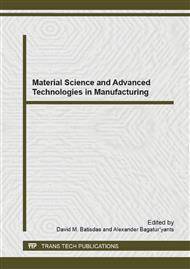[1]
Basha S A, Gopal K R, Jebaraj S. A review on biodiesel production, combustion, emissions and performance[J]. Renewable and Sustainable Energy Reviews, 2009, 13(6-7): 1628-1634.
DOI: 10.1016/j.rser.2008.09.031
Google Scholar
[2]
ASTM D 6751-12, Standard specification for biodiesel fuel blend stock (B100) for middle distillate fuels[S].
DOI: 10.1520/d6751-06b
Google Scholar
[3]
Tan P Q, Hu Z Y, Lou D M, et al. Exhaust emissions from a light-duty diesel engine with Jatropha biodiesel fuel[J]. Energy, 2012, 39(1): 356-362.
DOI: 10.1016/j.energy.2012.01.002
Google Scholar
[4]
Li B, Lou D M, Tan P Q, et al. Regulated and non-regulated emission characteristics of an engine fuelled with bio-diesel[J]. Chinese Internal Combustion Engine Engineering, 2009, 05: 22-26.
Google Scholar
[5]
Di Y, Cheung C S, Huang Z. Experimental investigation on regulated and unregulated emissions of a diesel engine fueled with ultra-low sulfur diesel fuel blended with biodiesel from waste cooking oil[J]. Science of the Total Environment, 2009, 407(2): 835-846.
DOI: 10.1016/j.scitotenv.2008.09.023
Google Scholar
[6]
Lou D M, Shen H Q, Hu Z Y, et al. Research on performance of diesel engine operating on different biodiesel blends[J]. Chinese Internal Combustion Engine Engineering, 2011, 32(1): 29-33.
Google Scholar
[7]
Ishikawa N, Uekusa T, Nakada T, et al. DI diesel emission control by optimized fuel injection: 2004 SAE World Congress, 2004[C].
DOI: 10.4271/2004-01-0117
Google Scholar
[8]
Kim M Y, Yoon S H, Lee C S. Impact of split injection strategy on the exhaust emissions and soot particulates from a compression ignition engine fueled with neat biodiesel[J]. Energy and Fuels, 2008, 22(2): 1260-1265.
DOI: 10.1021/ef700537w
Google Scholar
[9]
Lin J J. Experimental study on NOX emission influence of injection parameters on diesel engine fueled with biodiesel[D]. Shanghai Tongji University, 2013: 20-27.
Google Scholar
[10]
Shi X Y. Study on influence of fuel injection strategy on performance and exhaust emission of diesel engine[D]. Shandong University, 2007: 25-27.
Google Scholar
[11]
Xie F X, Hong W, Duan W, et al. Numerical analysis about effect of close post-injection on combustion process of common-rail diesel engine[J]. Journal of Jilin University (Engineering and Technology Edition), 2010, 05: 1193-1198.
Google Scholar
[12]
Poorghasemi K, Ommi F, Yaghmaei H, et al. An investigation on effect of high pressure post injection on soot and NO emissions in a DI diesel engine[J]. Journal of Mechanical Science and Technology, 2012, 26(1): 269-281.
DOI: 10.1007/s12206-011-1009-4
Google Scholar
[13]
Kegl B. Experimental investigation of optimal timing of the diesel engine injection pump using biodiesel fuel[J]. Energy and Fuels, 2006, 20(4): 1460-1470.
DOI: 10.1021/ef050405a
Google Scholar
[14]
Goldwine G, Sher E. Experimental investigation of the effect of split injection on diesel engine performance[J]. International Journal of Vehicle Design, 2009, 50(1-4): 66-90.
DOI: 10.1504/ijvd.2009.024969
Google Scholar
[15]
Ye P, Prabhakar B, Boehman A L. Experimental investigation of the impact of post-injection on emissions, combustion and lubricant dilution in a diesel engine with B20 fuel[J]. International Journal of Engine Research, 2013, 14(1): 12-22.
DOI: 10.1177/1468087412439837
Google Scholar


